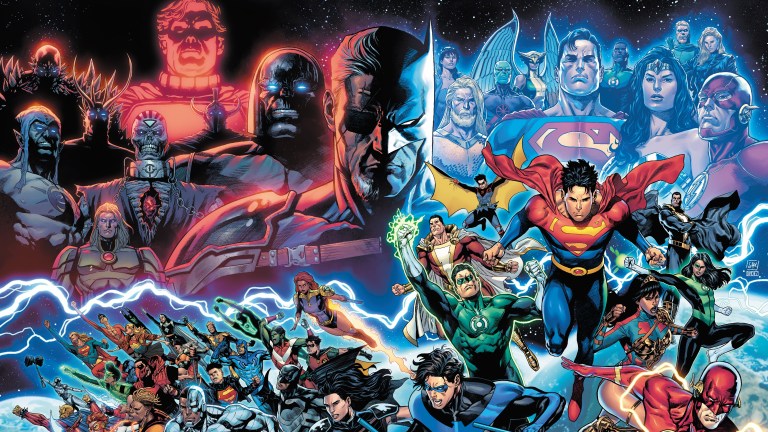What Does Dark Crisis Mean for the DC Universe?
The new DC event Dark Crisis promises big changes for the DCU and a new generation of DC superheroes.

DC has announced their biggest summer crossover since Dark Nights: Death Metal: Joshua Williamson and Daniel Sampere’s Dark Crisis, which will kick off with a #0 issue for Free Comic Book Day. But exactly what Dark Crisis is remains a bit of a mystery beyond some lovely teaser art and a promotional video.
Dark Crisis looks like it springs right out of Williamson’s multiversal revision from Justice League Incarnate. In the fourth issue of that series, we get a reconfigured, welded-together history of the DC Universe that slaps every crisis – from the classic Wolfman/Perez joint, through Zero Hour, Infinite Crisis, 52, Final Crisis, Multiversity, Doomsday Clock, and the Metal Wars – onto one coherent timeline. Behind all of them: The Great Darkness, the nothingness at the start of time, furious about being forced into a truce with the Light.
But where is it all going? Every Crisis ends with a massive status quo shift, and it’s reasonable to expect Dark Crisis to be the same. Here’s what we think it’s all about based on what we have seen so far.
DC 5G IS FINALLY HERE
With Williamson writing approximately a third of the mainline DCU’s total output, it might be easy to forget that he has been in the lead car of the DCU all the way back to Rebirth, qualifying as the second (or third) longest tenured writer to ever tackle The Flash. He wrote the first big Rebirth crossover in Justice League vs. Suicide Squad, and handled key chapters in all of the various Metal books. So he’s been around since before the next generation of heroes – Jon Kent, Yara Flor, and Jace Fox – were even a twinkle in editorial’s eye. Two editorial regimes ago.
DC’s abandoned 5G initiative was the brainchild of Dan DiDio, a story that would have seen Jace, Yara, and Jon – the Fifth Generation of DC heroes (don’t think too hard about this please), hence 5G – replacing Bruce, Diana, and Clark as the big three heroes of the DCU. The plans were nebulous when DiDio was let go by the company, so not much is available beyond that because not much existed. But we can be fairly sure that a lot of what did exist – particularly much of the future looking ideas – was folded into Future State,
At its time of death, 5G was actually barreling towards release. The stories about DC’s myriad reboots and relaunches are numerous, but the general consensus around that era is that when it came to reboots, DC was building the plane while they were flying it. There’s a good chance that 5G would have been every bit the continuity mess that the New 52 or Rebirth were. Instead, Dark Crisis gives us a 5G that was organically built, seeded over years of story across multiple books. At the very least, the planning should make a more coherent impact on DC continuity.
A CRISIS OF CRISES
It looks like the gathering of villains is giving us someone from every Crisis…and a few other non-Crisis DC eras.
The elevator pitch for Dark Crisis is Pariah (the lone survivor of a parallel dimension who inadvertently caused Crisis on Infinite Earths and was doomed to zap around the multiverse, witnessing the deaths of various Earths and unable to intercede) has found a way to return his universe to existence. His plan is to use the Great Darkness to obliterate Earth 0 to do so. And it looks like he’s gathering a host of bad dudes to help him: Superman-killer Doomsday; Wonder Woman arch-nemesis Ares; Darkseid; The Empty Hand, the big bad of Multiversity; Eclipso; Nekron; and someone I can’t quite figure out (Mordred? Neron? Hank Hall in a new outfit?).
If you look at this group just right, that’s someone from every major phase of the DCU.
The Great Darkness is a pre-Crisis concept, first introduced in Alan Moore and Steve Bisette’s Swamp Thing (not to be confused with the Great Darkness in the best Legion of Super-Heroes story of all time, “The Great Darkness Saga”). Pariah is obviously from the first Crisis. Doomsday and Ares are from the last time the heroes were replaced in a concerted publishing effort – the early 90s, when Superman was killed by Doomsday, and Ares was starting a war of the gods. Nekron incited the Blackest Night. The Empty Hand is a very weird pull, but Multiversity was great and Williamson seems to like the same DC comics I do for the same reasons, so I’ll roll with it. Darkseid was the sub-boss of Final Crisis. And Eclipso was a major player in the lead up to Infinite Crisis.
Really the only crisis not accounted for by this villain team is Zero Hour; hence the Hank Hall speculation. And the only person in this image not prominently affiliated with a major Crisis is Deathstroke, but since he’s the star of one of the books Williamson is steering into this event, I’ll give him a pass.
This use of the full tapestry of DC history is right up Williamson’s alley. The man has an encyclopedic knowledge of DC continuity, and his tenure as the driving force of the DCU has been all about respecting it all.
EVERYTHING COUNTS, EVERYTHING MATTERS. EVEN MORE
DC’s continuity mantra since what we’re now calling the Metal Wars – Dark Nights: Metal and Death Metal – has been “everything counts, everything matters.” And Justice League Incarnate’s fourth issue spent a fair bit of time putting all of that into place.
Here’s a quick summary: time dawned when the concept of “story” was introduced to the infinite void of nothingness, creating the multiverse. But the blast of light immediately created conflict with the darkness; the Great Darkness, fighting back against everything in existence and triggering the original Crisis on Infinite Earths. Superheroes were the natural immune system of the multiverse, and they fought together to combat the Great Darkness and its agent, the Anti-Monitor, until Swamp Thing brokered a truce between the dark and the light.
The Great Darkness kept trying to destroy everything, sending agents like Magog, Extant, Superboy Prime, and Mister Mind, culminating in another full on Crisis – Final Crisis, which was triggered by Darkseid trying to gain control of the Great Darkness for himself to use. He failed, but not before the Great Darkness realized that superheroes were the real problem, so it started trying to break the heroes with increasingly desperate attacks and manipulations, first by making Barry Allen break time in Flashpoint, then by poisoning Dr. Manhattan into stealing time away from the multiverse in Doomsday Clock.
It also started picking at the multiverse one universe at a time using The Gentry, a group of evil concepts that…it’s really hard to explain that in brief, but this all happened in The Multiversity and it’s one of the best DC events ever, so go read that. Anyway the Gentry caused a group of heroes from the multiverse to band together and form Justice Incarnate, who quarantined the baddies on Earth 7. And there they waited, while the Great Darkness raised the Dark Multiverse and tried to destroy Earth 0, the main DCU.
Darkseid, killed by his failure in Final Crisis and unleashed during The Multiversity, reemerges during this time, again scheming to harness the power of the Great Darkness. But he fails, getting literally stomped by the Great Darkness’ agent on Earth 7.
That was…a lot, and I’m proud of you for sticking with it. It’s a lot of fun to describe, though, and even more fun to read through. And while Justice League Incarnate is an exercise in lining up macro continuity, Dark Crisis, for all its promises of big sweeping action and universe-shattering consequence, looks very micro in some of its continuity consequences.

REMEMBER THE TITANS?
The other promotional image, the two page interior spread from Dark Crisis, has an awful lot of Teen Titans on it. In fact, it’s got a quick look at the three main eras in Titans history: the Silver Age team across the top row; the Wolfman-Perez New Teen Titans crew in the center; and the Geoff Johns/Mike McKone team on the right.
And beyond that, Williamson has released the first page of the first issue, though it’s unlettered. It’s Robin taking his oath to wage war on crime from Batman in a candlelit ceremony, back from the days before Robin started being a legacy admission. Talking about it, Williamson explicitly set the concept of legacy within the greater light/dark war he’s been setting up.
All this talk of legacy feels weird for a publishing line only putting out one Titans book at the moment. Sure, Nightwing is a bestseller and critical darling, and The Flash has Wally as a lead, but those aren’t played as Titans books. What if Dark Crisis’ emphasis on legacy is setting up a big Titans push?
Williamson has been talking about legacy characters almost since he started writing for DC, and his favorite era, as he indicated to us back at the start of Infinite Frontier, is the early ’90s, when the line was explicitly about legacy heroes in a way that changed the industry. You need to look no further than Connor Hawke’s return as the greatest fighter in the DC Universe in Robin for proof of his love.
There are a lot of generations of Titans to mine for a new series, but the Earth-8 generation (Earth 8 was speculated by Alexander Luthor in Infinite Crisis to have been the eventual home planet of the 90s generation of replacement heroes – Kyle Rayner, Donna Troy, Connor Hawke, etc) seems particularly ripe for a reunion.
As does DC’s publishing line. The line is very tentpole heavy right now – lots of Batman and Superman and Wonder Woman books, with a scattering of unrelated ones. While organizing it this way seems to be working, it’s not too much to think the market might support a second Teen Titans book. It sure seems like they’re getting a push.
Dark Crisis #0 FCBD Special Edition will be available on May 7. Justice League: Road to Dark Crisis #1 hits on May 31. Dark Crisis #1 will follow in June.
